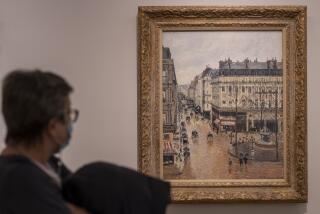Legal fight over California’s unique art-sales law nears climax
Past and future paydays for American artists were at stake in a Pasadena courtroom Tuesday as a group of them tried to salvage a special privilege that only California confers: the right to pocket a 5% royalty whenever a California collector or gallery sells their work on the secondary market.
Lawsuits brought in 2011 by several prominent artists or their heirs aimed to force Sotheby’s and Christie’s, two leading international art auction houses, and EBay to collect the 5% royalty.
But a federal judge in Los Angeles dismissed the case in 2012, finding that the California Legislature exceeded its authority when it passed the Resale Royalty Act in 1976. The judge ruled that the royalty requirement improperly butts into matters of interstate commerce that California had no right to regulate.
Over time, some California sellers have abided by the law and others have not.
Payments are supposed to be made to any artist who is an American citizen or who is a California resident -- if his or her work is being sold by a California owner, regardless where in the United States the sale occurs. The royalty right extends 20 years after an artist’s death.
The lawsuits brought by living artists Laddie John Dill and Chuck Close, and by heirs of Sam Francis and Robert Graham, sought to give the statute more bite while compensating them for missed payments from Sotheby’s, Christie’s and EBay.
The artists’ attorney, Eric George, said that two other major auction houses, Bonhams & Butterfield’s and Phillips de Pury and Co., comply with the law. But it also applies to private sales by Californians, obligating the seller to track down the artist and pay him or her the 5% cut on any sale over $1,000.
The hearing Tuesday was before an 11-judge panel of the U.S. 9th Circuit Court of Appeals, which heard arguments from both sides -- and from Aimee Feinberg, a deputy solicitor for the state who was trying to defend the law as a proper exercise of the legislature’s power.
The hourlong proceedings focused almost exclusively on legal doctrines concerning interstate commerce, copyright law and tax law. No artist’s name was mentioned and almost nothing was said about art, except when Judge Harry Pregerson asked, “What is the purpose of this statute?”
“It’s to benefit the arts, to make the state richer for artists,” George replied.
Resale royalties are part of business as usual throughout the European Union and in some other international markets. But they have been opposed in the U.S. by art dealers and auctioneers.
Deanne Maynard, an attorney for Sotheby’s who also carried the ball for Christie’s and EBay at the hearing, contended that U.S. copyright law specifies that once an object is sold, the creator is not entitled to be paid for subsequent sales.
Periodic efforts to establish a nationwide resale royalty act akin to the one in Europe have stalled in Congress, most recently in 2011. But a new version was introduced early this year, calling for a 5% resale royalty on auction sales, with the royalty capped at $35,000.
In a recent article on the website of his New York City law firm Herrick, Feinstein, which has an art law practice, attorney Barry Werbin wrote that this time signs are more positive for federal legislation on the matter.
Werbin noted that the U.S. Copyright Office has recommended establishing an artist resale royalty nationwide. It would put visual artists on the same footing as composers, playwrights and authors, who must be paid every time a work is resold as a live performance, a recording or a book.
However, George, the artists’ attorney in California, said he’s skeptical about the national law’s chances.
“I’d be shocked if it happened,” he said, because it’s easy for opponents to paint a new royalty privilege as “government overreach” that burdens private businesses.
More to Read
The biggest entertainment stories
Get our big stories about Hollywood, film, television, music, arts, culture and more right in your inbox as soon as they publish.
You may occasionally receive promotional content from the Los Angeles Times.







